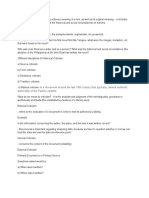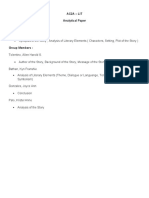How To Analyze Setting in Literature
How To Analyze Setting in Literature
Uploaded by
Veronika SwantiCopyright:
Available Formats
How To Analyze Setting in Literature
How To Analyze Setting in Literature
Uploaded by
Veronika SwantiOriginal Description:
Original Title
Copyright
Available Formats
Share this document
Did you find this document useful?
Is this content inappropriate?
Copyright:
Available Formats
How To Analyze Setting in Literature
How To Analyze Setting in Literature
Uploaded by
Veronika SwantiCopyright:
Available Formats
How to Analyze Setting in Literature
Kristine Tucker
Home » Language & Lit
Setting is an important part of any story or poem because it explains where and when the events take place. The setting helps
create the mood and set the tone for the literary piece. You can analyze the setting by examining the surrounding environment,
background, historical place in time and geographic location. Use specific examples from the story or poem to support your
analysis.
Locate the Main Setting
Locate the primary place and time period where the majority of the action occurs. Some stories take place in a variety of settings
and span different time periods, but there's usually one location and time period where the most significant scenes and the
bulk of the action occurs. For example, in "Holes" by Louis Sachar, the primary setting is the present-day Texas desert at a
juvenile detention center for boys. Though the story includes scenes from the late 19th and 20th centuries, the primary setting is the
fictional boys' camp in Green Lake, Texas. Similarly, even though its characters visit other locations and reference other time
periods, the primary setting in "Twilight" by Stephenie Meyer is the present-day small, rainy town of Forks, Washington.
Evaluate the Mood
Examine the importance of the setting. The setting provides a backdrop for the characters' involvement in the world around them
and creates the mood for the story or poem. It's an essential part of understanding and interpreting the meaning or message of
the story. In "Holes," the desert setting creates a dry and isolated backdrop that supports the story's mood; the teenagers at the
camp often feel lonely, hopeless and abandoned. In "Twilight," the cold, damp, Washington forest establishes the mood for the
conflict between cold-blooded vampires and their adversaries.
Assess the Atmosphere
Consider the immediate surroundings, including the geographical location and the date, and how they affect the overall
atmosphere of the story or poem. For example, "The Scarlet Letter" by Nathaniel Hawthorne takes place in the 1630s in Boston
when the Puritans looked harshly upon any form of sin -- especially adultery. The strictly religious town setting establishes a sense
of law and order, creating a stuffy atmosphere with little room for flaws in human nature. The setting sets the stage for the
conflicts and resolutions in the story.
Examine the Details
Pay close attention to detailed descriptions of the setting, such as weather, the natural surroundings or the inside of a house or a
room. These details provide clues as to the emotional condition of the characters. For example, in "The Old Man and the Sea,"
Ernest Hemingway describes the sea by saying, "She is kind and very beautiful. But she can be so cruel." This description helps
readers understand the protagonist's love-hate relationship with the sea and with his favorite pastime -- fishing. It also reveals the
protagonist's state of mind; he's conflicted and troubled by uncontrollable circumstances in his life.
Cite this Article
References
Roane State Community College OWL: Literary Analysis -- Using Elements of Literature
Holes; Louis Sachar; 1998
Twilight; Stephenie Meyer; 2005
Texas A&M University Writing Center: Analyzing Novels & Short Stories
The Scarlet Letter; Nathaniel Hawthorne; 1892
University of Hawaii System: Analyzing and Interpreting Stories
UDL Editions by Cast: Narrative Elements -- Setting
The Old Man and the Sea; Ernest Hemingway
You might also like
- Midnight Sun Edward's Version of Twilight - Stephenie Meyer PDFDocument1 pageMidnight Sun Edward's Version of Twilight - Stephenie Meyer PDFjenoss0% (2)
- Book 1 Breaking Dawn Edward's P.ODocument153 pagesBook 1 Breaking Dawn Edward's P.OSean Phillip Alexander Harrison83% (6)
- Breaking Dawn 2-7Document163 pagesBreaking Dawn 2-7Ana Karen96% (25)
- How To Analyze A Short StoryDocument3 pagesHow To Analyze A Short StoryMaríaDeLosAngelesHeldNo ratings yet
- Function of LiteratureDocument1 pageFunction of LiteratureAdrian DavidNo ratings yet
- Victorian Period 1832-1901 PDFDocument18 pagesVictorian Period 1832-1901 PDFAndrew LatorcaiNo ratings yet
- Loner by NillaDocument865 pagesLoner by NillaAddie100% (1)
- Annotated Bibliography For Assignment 2Document5 pagesAnnotated Bibliography For Assignment 2Jasmine Delaine100% (1)
- Lesson Plan (Authors' Purpose in Writing)Document4 pagesLesson Plan (Authors' Purpose in Writing)Cristy Samonte Busano100% (1)
- MythologyDocument9 pagesMythologyrensebastianNo ratings yet
- 21 Century Literature From Philippine and The World: Tecarro College Foundation, IncDocument24 pages21 Century Literature From Philippine and The World: Tecarro College Foundation, IncMars IndyNo ratings yet
- Setting Notes - AP Short StoryDocument2 pagesSetting Notes - AP Short StoryRyanGoldenNo ratings yet
- The Cask of AmontilladoDocument43 pagesThe Cask of AmontilladoZechaina Udo100% (2)
- Different Forms of PoetryDocument13 pagesDifferent Forms of Poetrykhryslerbongbonga30No ratings yet
- Summer Solstice: Nicomedes Marquez JoaquinDocument21 pagesSummer Solstice: Nicomedes Marquez JoaquinDyosa AngeNo ratings yet
- Setting in Drama: Fairy TalesDocument2 pagesSetting in Drama: Fairy Talessuccia putri nabilaNo ratings yet
- Visayas Hybrid Modes in Local ColorDocument7 pagesVisayas Hybrid Modes in Local ColorABDULLAH RENDONNo ratings yet
- Literary ApproachesDocument22 pagesLiterary ApproachesMark DiamaNo ratings yet
- What Are The Approaches To LiteratureDocument6 pagesWhat Are The Approaches To LiteratureDaniella MarizNo ratings yet
- Modern Fantasy Literary Analysis The Lion The Witch and The WardrobeDocument5 pagesModern Fantasy Literary Analysis The Lion The Witch and The Wardrobemissc3301No ratings yet
- CREATIVE WRITING Reading and Writing FictionDocument4 pagesCREATIVE WRITING Reading and Writing FictionrenzpaulorodriguezNo ratings yet
- Lesson II PhrasesDocument26 pagesLesson II PhrasesRuth MagoodsNo ratings yet
- FictionDocument2 pagesFictionteachenglandNo ratings yet
- Elements of FictionDocument5 pagesElements of FictionBea Dacillo BautistaNo ratings yet
- Traditional LiteratureDocument3 pagesTraditional LiteratureLorretta KongNo ratings yet
- Q2 - LE - English 7 - Lesson 3 - Week 4Document21 pagesQ2 - LE - English 7 - Lesson 3 - Week 4Eden Solitario Rique100% (1)
- Survey of Philippine Literature in EnglishFirstSemSY2023 2024 AutosavedDocument29 pagesSurvey of Philippine Literature in EnglishFirstSemSY2023 2024 AutosavedDaisy Mae TedlosNo ratings yet
- Story Behind Noli Me Tangere PDFDocument25 pagesStory Behind Noli Me Tangere PDFIan De La PeñaNo ratings yet
- Foreshadowing: What Is It?Document11 pagesForeshadowing: What Is It?David Veach100% (2)
- What Is A CharacterDocument20 pagesWhat Is A CharacterMARLYN CORPUZ100% (1)
- Introduction To Literary GenresDocument3 pagesIntroduction To Literary GenresMirah Meizhae100% (1)
- Linguistic ContextDocument129 pagesLinguistic ContextcrakuheadoNo ratings yet
- The Analysis of SettingDocument8 pagesThe Analysis of SettingadolfNo ratings yet
- Dead Stars: Paz Marquez BenitezDocument21 pagesDead Stars: Paz Marquez BenitezsucksNo ratings yet
- Feminism in Selected 21 Century Palanca Award-Winning Short Stories in IlocanoDocument24 pagesFeminism in Selected 21 Century Palanca Award-Winning Short Stories in IlocanoEdward Almazan100% (3)
- Children and Adolescent Literature FINALS 1st SEMDocument8 pagesChildren and Adolescent Literature FINALS 1st SEMJesserick Paunel EmpelesNo ratings yet
- Meaning Analysis of Metaphors Found in The Cinderella Short Fairy Story by Brother GrimmDocument16 pagesMeaning Analysis of Metaphors Found in The Cinderella Short Fairy Story by Brother GrimmEsuk Kae0% (2)
- The Elements of FictionDocument4 pagesThe Elements of FictionlealdeosaNo ratings yet
- Contemporary, Popular & Emergent LiteratureDocument41 pagesContemporary, Popular & Emergent LiteratureJr RequitaNo ratings yet
- Week 3 (3RD QTR) - English 8Document1 pageWeek 3 (3RD QTR) - English 8Jochelle100% (1)
- Pretenders, The Sociological Approach Emphasizes Social Significance and Engagement, As WellDocument4 pagesPretenders, The Sociological Approach Emphasizes Social Significance and Engagement, As WellJim ReyesNo ratings yet
- Activity SheetsDocument4 pagesActivity Sheetsrizalina maxilomNo ratings yet
- Historical CriticismDocument2 pagesHistorical CriticismNehemiah BuctuanNo ratings yet
- Literature HandoutDocument11 pagesLiterature HandoutJealyn FloresNo ratings yet
- Moral Political Approach EDITED FINALDocument4 pagesMoral Political Approach EDITED FINALCHARLIES CutiesNo ratings yet
- Structuralism and Post Structuralism PDFDocument18 pagesStructuralism and Post Structuralism PDFJomar MarianoNo ratings yet
- Ac2A - Lit Analytical Paper Group LeaderDocument13 pagesAc2A - Lit Analytical Paper Group LeaderheheheheNo ratings yet
- Bilingual ReportDocument11 pagesBilingual ReportEph Fur100% (1)
- Subversions, Appropriations and IntertextualityDocument4 pagesSubversions, Appropriations and IntertextualityLight95100% (1)
- Theme LessonDocument2 pagesTheme Lessonapi-261363827No ratings yet
- 21st CLPW Reviewer 2Document3 pages21st CLPW Reviewer 2Archie BaldescoNo ratings yet
- The Short Story: RationaleDocument23 pagesThe Short Story: RationalewoodycoquinNo ratings yet
- The Blue Stones ExplainDocument21 pagesThe Blue Stones ExplainMisaha مساحةNo ratings yet
- A Piece of StringDocument19 pagesA Piece of StringAli Zafar100% (1)
- ACAD2Document2 pagesACAD2イヴ・ アケル・ タヨNo ratings yet
- In The Midst of HardshipDocument14 pagesIn The Midst of HardshipJules GajesNo ratings yet
- Learning Activity Sheets Week 5-6Document4 pagesLearning Activity Sheets Week 5-6Bai-Norali MontañerNo ratings yet
- On The Little PrinceDocument2 pagesOn The Little PrinceIan De La CruzNo ratings yet
- Archetypal Criticism: Group 6 Kimberly Calulo Jeanne Herrera Francesca Lapid Karizza MallariDocument17 pagesArchetypal Criticism: Group 6 Kimberly Calulo Jeanne Herrera Francesca Lapid Karizza MallariTimothy ChanNo ratings yet
- 2 What Is Epic PoetryDocument2 pages2 What Is Epic PoetryBetina RoselliniNo ratings yet
- Ma. Kathleen Pearl Grande Bs Che - IvDocument23 pagesMa. Kathleen Pearl Grande Bs Che - IvKat-kat GrandeNo ratings yet
- A Study Guide for Walter Raleigh's "The Nymph's Reply to the Shepherd"From EverandA Study Guide for Walter Raleigh's "The Nymph's Reply to the Shepherd"No ratings yet
- Nathaniel Hawthorne EssaysDocument3 pagesNathaniel Hawthorne Essaysezknbk5h100% (2)
- English Extension - Dracula Vs TwilightDocument2 pagesEnglish Extension - Dracula Vs TwilightbleakfamineNo ratings yet
- Youre Too Sweet For MeDocument62 pagesYoure Too Sweet For Meyoonmin1154No ratings yet
- Twilight The Graphic Novel Volume 1Document2 pagesTwilight The Graphic Novel Volume 1vasudha130550% (2)
- Forever Is A Promise (Ness and Jacob Story) Chapter 2 and Part I of CH 3Document12 pagesForever Is A Promise (Ness and Jacob Story) Chapter 2 and Part I of CH 3Akshara Srri100% (3)
- Complete The Reading. Use Present Simple, Past Simple or Present PerfectDocument3 pagesComplete The Reading. Use Present Simple, Past Simple or Present PerfectMari OnofrioNo ratings yet
- KEY TỔNG HỢP SÁCH CHUYÊN ĐỀ FORMATED 2 57Document56 pagesKEY TỔNG HỢP SÁCH CHUYÊN ĐỀ FORMATED 2 57Khánh HuyềnNo ratings yet
- Writing Mormonism - Vampires and Werewolves in The Twilight Saga As Exemplars For An Ideal Way of LivingDocument56 pagesWriting Mormonism - Vampires and Werewolves in The Twilight Saga As Exemplars For An Ideal Way of LivingXander ClockNo ratings yet
- Testes Ingles 7ºDocument26 pagesTestes Ingles 7ºMónica Carneiro100% (1)
- Pink Beach: Mozart's MusicDocument7 pagesPink Beach: Mozart's MusicErikaa RahmaNo ratings yet
- Assignment Number 01Document6 pagesAssignment Number 01Sumeet KumarNo ratings yet
- New Moon E.P.O.V.Document2 pagesNew Moon E.P.O.V.karina_nicholeNo ratings yet
- CritiqueDocument2 pagesCritiqueMaryan CerboNo ratings yet
- Fanfic - Isle Esme CH 1, Twilight - FanFictionDocument11 pagesFanfic - Isle Esme CH 1, Twilight - FanFictionTássia HolandaNo ratings yet
- Ebook Thumb UpdatedDocument16 pagesEbook Thumb Updatedmee0% (1)
- My Ebook LibraryDocument80 pagesMy Ebook LibraryPauline Jardine18% (11)
- VampireDocument4 pagesVampirechoddasharanNo ratings yet
- ANSWERDocument4 pagesANSWERAisha MuneerNo ratings yet
- Referat EnglezaDocument3 pagesReferat EnglezaAnne RitutzaNo ratings yet
- Alliteration: Franscine May T. Mostiero G10-MangoDocument4 pagesAlliteration: Franscine May T. Mostiero G10-MangoJoan AlmarezNo ratings yet
- Guanio-Uluru, L. - Ethics and Form in Fantasy Literature. Tolkien, Rowling and MeyerDocument269 pagesGuanio-Uluru, L. - Ethics and Form in Fantasy Literature. Tolkien, Rowling and MeyerElena NeculaiNo ratings yet
- Đề Ta THPTQG 2022Document320 pagesĐề Ta THPTQG 2022K60 Trần Phan Anh ĐàoNo ratings yet
- Click CVDocument11 pagesClick CVJohn Hinderaker100% (1)
- Thesis On Twilight SagaDocument7 pagesThesis On Twilight SagaWhereCanIFindSomeoneToWriteMyCollegePaperSingapore100% (2)
- Green GoldDocument397 pagesGreen Goldtmccullough66632No ratings yet

























































































